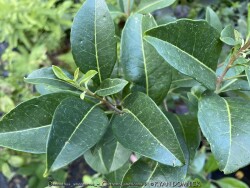

Devilwood (Osmanthus americanus / Cartrema americana) has very hard and dense wood, hence the name. It is a slow-growing evergreen shrub or small tree native to southeastern North America and Mexico. Bright green simple leaves emerge in spring turning deeper green in summer. Cream white flowers borne on separate trees and female trees produce abundant blue/black fruit. Growth habit is somewhat open so don't count on it to provide screening or density. Grows in sun or shade but in the northern part of its range, growth is too slow and sparse in the shade. Devilwood grows in most soils including moist ones and occasional flooding. This making it an ideal rain garden plant. Becoming more drought tolerant when established, our 40 inches of typical rainfall in Eastern Kansas is sufficient if planted in good soils. The cold hardiness is surprising: as a zone 5, this could be one of the most cold-tolerant broadleaf evergreens trees available! It survived -16 degrees F and a week of single digit highs in February, 2021 with no damage. It even maintains bright green foliage in winter opposed to a dingy brownish-green like some evergreens. Useful in the garden as a background evergreen shrub or small tree. Sold as Osmanthus americanus, Cartrema americana is technically it's new botanical name.
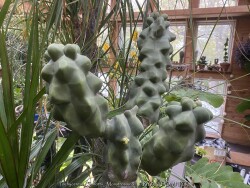

Pachycereus Schottii (Pachycereus schottii f. monstrosus) is native to the desert regions of mainland Mexico and the Baja California peninsula of Mexico. The monstrous form is restricted to a small area about halfway down the Baja peninsula. In the wild, established plants are hardy to about 25 degrees F for short periods of time. Totem pole cacti are usually grown as a patio or house plant in Kansas. Grow in full sun with occasional extra watering including that which comes from rainfall. Repotting may or may not be needed depending on how large you want the plant to grow; plants can continue to grow taller and tolerate extremely root-bound pots but may need wind bracing. If repotting, make sure to use a sharp draining medium organic cactus mix with plenty of sand and perlite. To play is safe, potted plants are best moved in before night temperatures get below 45 degrees F. It is important to avoid the combination of wet and cold. Before extreme cold occurs, move to a bright interior window over the winter with no watering and keep above freezing. As a winter house plant, it will look presentable all winter long with no waterings.(also to prevent lanky winter growth) As a permanent house plant, provide bright light and allow the soil to dry between waterings for many years of carefree enjoyment. Plants grown permanently indoors may begin to elongate stretching for light and lose their spine color. It can be hard to reproduce the intense UV sunlight they need so moving outside for the summer is best. Generally if moving outside for the summer, allow 1-2 weeks of part shade or morning sun before placing in full sun. Plants with time to acclimate will thrive in full hot sun but be careful not to rush it or sunburning can occur. Potted plants are very low maintenance. I have never seen any insect problems on this plant. Pachycereus schottii f. monstrosus is the most attractive monstrous form with pronounced knobby tubercles and smooth green skin; it is rare and will command a higher price than most other houseplants. Another naturally occuring monstrous form, Pachycereus schottii f. mieckleyanus, also has smooth green skin but thinner stems with less tubercles.


Pachycereus Schottii (Pachycereus schottii f. monstrosus) is native to the desert regions of mainland Mexico and the Baja California peninsula of Mexico. The monstrous form is restricted to a small area about halfway down the Baja peninsula. In the wild, established plants are hardy to about 25 degrees F for short periods of time. Totem pole cacti are usually grown as a patio or house plant in Kansas. Grow in full sun with occasional extra watering including that which comes from rainfall. Repotting may or may not be needed depending on how large you want the plant to grow; plants can continue to grow taller and tolerate extremely root-bound pots but may need wind bracing. If repotting, make sure to use a sharp draining medium organic cactus mix with plenty of sand and perlite. To play is safe, potted plants are best moved in before night temperatures get below 45 degrees F. It is important to avoid the combination of wet and cold. Before extreme cold occurs, move to a bright interior window over the winter with no watering and keep above freezing. As a winter house plant, it will look presentable all winter long with no waterings.(also to prevent lanky winter growth) As a permanent house plant, provide bright light and allow the soil to dry between waterings for many years of carefree enjoyment. Plants grown permanently indoors may begin to elongate stretching for light and lose their spine color. It can be hard to reproduce the intense UV sunlight they need so moving outside for the summer is best. Generally if moving outside for the summer, allow 1-2 weeks of part shade or morning sun before placing in full sun. Plants with time to acclimate will thrive in full hot sun but be careful not to rush it or sunburning can occur. Potted plants are very low maintenance. I have never seen any insect problems on this plant. There are 2 or more forms. Compared to Pachycereus schottii f. monstrosus, Pachycereus schottii f. mieckleyanus (Pachycereus schottii f. monstrosus 'Minor'), has smooth green skin but thinner stems with less tubercles. This form is faster growing.
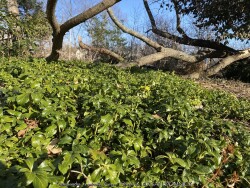

***Description for this perennial available with future update!***Green Sheen Japanese Pachysandra, is also known as Pachysandra terminalis 'Green Sheen'


***Description for this perennial available with future update!***Native Roundleaf Groundsel / Packera, is also known as Packera obovata


***Description for this perennial available with future update!***Native Roundleaf Groundsel / Packera, is also known as Packera obovata


Peonies (Paeonia), along with roses are one of the most universally well-known flowers. The toughness and durability of this plant can be seen in cemeteries or around abandoned houses, surviving decades even 100 years or more without care. Peonies are native to China in cold continental climate areas but also do well in Kansas. Large flowers come in different shades of white, red, and pink. Peonies bloom usually around Memorial Day hence their popularity and cemeteries. Blooming lasts about 2 weeks but can be short-lived if a thunderstorm happens during the last week of blooming when petals are fully open. In zone 6 and south, the foliage is glossy green and attractive throughout the first half of summer. Usually, by late summer, foliage is tattered from drought stress and diseases. This has no ill effect on the health of the plant as it is already set its growth buds for next year. In northern areas (USDA zones 3-5), Peony foliage lasts all summer and turns a brilliant red and orange color in the fall. Due to its need for cold winters, peonies will not grow well further south than zone 8b. Gardeners in south Florida have had success getting peonies to bloom by dumping a bag of ice on the dormant plant every day for 5-6 weeks in winter: sounds like a lot of work huh! Due to its cold tolerance, peonies may be grown in above-ground pots or raised planters year-round. When planting outside, be careful to plant at the correct depth with pink buds slightly below the soil or plants will not bloom. Overall, peonies are a very reliable long-lived plant in Kansas surviving everything. But they do require some maintenance to look their best. Ultra cold-hardy plants from northern climates normally dislike our long hot humid summers; although we are on the Southern edge of this plant's adaptability, it still survives reasonably well here. Look for a cold microclimate planting location such as East or North exposure. Paeonia 'Coral Sunset' features double flowering multi-colored (Pink,Salmon,Peach,Gold) blooms.


Peonies (Paeonia), along with roses are one of the most universally well-known flowers. The toughness and durability of this plant can be seen in cemeteries or around abandoned houses, surviving decades even 100 years or more without care. Peonies are native to China in cold continental climate areas but also do well in Kansas. Large flowers come in different shades of white, red, and pink. Peonies bloom usually around Memorial Day hence their popularity and cemeteries. Blooming lasts about 2 weeks but can be short-lived if a thunderstorm happens during the last week of blooming when petals are fully open. In zone 6 and south, the foliage is glossy green and attractive throughout the first half of summer. Usually, by late summer, foliage is tattered from drought stress and diseases. This has no ill effect on the health of the plant as it is already set its growth buds for next year. In northern areas (USDA zones 3-5), Peony foliage lasts all summer and turns a brilliant red and orange color in the fall. Due to its need for cold winters, peonies will not grow well further south than zone 8b. Gardeners in south Florida have had success getting peonies to bloom by dumping a bag of ice on the dormant plant every day for 5-6 weeks in winter: sounds like a lot of work huh! Due to its cold tolerance, peonies may be grown in above-ground pots or raised planters year-round. When planting outside, be careful to plant at the correct depth with pink buds slightly below the soil or plants will not bloom. Overall, peonies are a very reliable long-lived plant in Kansas surviving everything. But they do require some maintenance to look their best. Ultra cold-hardy plants from northern climates normally dislike our long hot humid summers; although we are on the Southern edge of this plant's adaptability, it still survives reasonably well here. Look for a cold microclimate planting location such as East or North exposure. Peony 'Flame' features single flowering red blooms displayed on the bold erect stems.
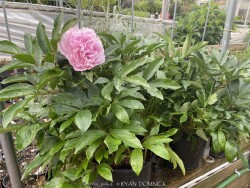

Peonies (Paeonia), along with roses are one of the most universally well-known flowers. The toughness and durability of this plant can be seen in cemeteries or around abandoned houses, surviving decades even 100 years or more without care. Peonies are native to China in cold continental climate areas but also do well in Kansas. Large flowers come in different shades of white, red, and pink. Peonies bloom usually around Memorial Day hence their popularity and cemeteries. Blooming lasts about 2 weeks but can be short-lived if a thunderstorm happens during the last week of blooming when petals are fully open. In zone 6 and south, the foliage is glossy green and attractive throughout the first half of summer. Usually, by late summer, foliage is tattered from drought stress and diseases. This has no ill effect on the health of the plant as it is already set its growth buds for next year. In northern areas (USDA zones 3-5), Peony foliage lasts all summer and turns a brilliant red and orange color in the fall. Due to its need for cold winters, peonies will not grow well further south than zone 8b. Gardeners in south Florida have had success getting peonies to bloom by dumping a bag of ice on the dormant plant every day for 5-6 weeks in winter: sounds like a lot of work huh! Due to its cold tolerance, peonies may be grown in above-ground pots or raised planters year-round. When planting outside, be careful to plant at the correct depth with pink buds slightly below the soil or plants will not bloom. Overall, peonies are a very reliable long-lived plant in Kansas surviving everything. But they do require some maintenance to look their best. Ultra cold-hardy plants from northern climates normally dislike our long hot humid summers; although we are on the Southern edge of this plant's adaptability, it still survives reasonably well here. Look for a cold microclimate planting location such as East or North exposure.
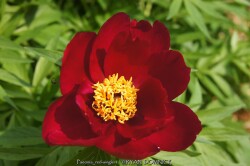

Peonies (Paeonia), along with roses are one of the most universally well-known flowers. The toughness and durability of this plant can be seen in cemeteries or around abandoned houses, surviving decades even 100 years or more without care. Peonies are native to China in cold continental climate areas but also do well in Kansas. Large flowers come in different shades of white, red, and pink. Peonies bloom usually around Memorial Day hence their popularity and cemeteries. Blooming lasts about 2 weeks but can be short-lived if a thunderstorm happens during the last week of blooming when petals are fully open. In zone 6 and south, the foliage is glossy green and attractive throughout the first half of summer. Usually, by late summer, foliage is tattered from drought stress and diseases. This has no ill effect on the health of the plant as it is already set its growth buds for next year. In northern areas (USDA zones 3-5), Peony foliage lasts all summer and turns a brilliant red and orange color in the fall. Due to its need for cold winters, peonies will not grow well further south than zone 8b. Gardeners in south Florida have had success getting peonies to bloom by dumping a bag of ice on the dormant plant every day for 5-6 weeks in winter: sounds like a lot of work huh! Due to its cold tolerance, peonies may be grown in above-ground pots or raised planters year-round. When planting outside, be careful to plant at the correct depth with pink buds slightly below the soil or plants will not bloom. Overall, peonies are a very reliable long-lived plant in Kansas surviving everything. But they do require some maintenance to look their best. Ultra cold-hardy plants from northern climates normally dislike our long hot humid summers; although we are on the Southern edge of this plant's adaptability, it still survives reasonably well here. Look for a cold microclimate planting location such as East or North exposure.
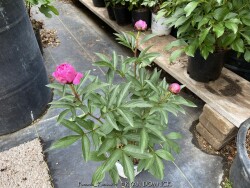

Peonies (Paeonia), along with roses are one of the most universally well-known flowers. The toughness and durability of this plant can be seen in cemeteries or around abandoned houses, surviving decades even 100 years or more without care. Peonies are native to China in cold continental climate areas but also do well in Kansas. Large flowers come in different shades of white, red, and pink. Peonies bloom usually around Memorial Day hence their popularity and cemeteries. Blooming lasts about 2 weeks but can be short-lived if a thunderstorm happens during the last week of blooming when petals are fully open. In zone 6 and south, the foliage is glossy green and attractive throughout the first half of summer. Usually, by late summer, foliage is tattered from drought stress and diseases. This has no ill effect on the health of the plant as it is already set its growth buds for next year. In northern areas (USDA zones 3-5), Peony foliage lasts all summer and turns a brilliant red and orange color in the fall. Due to its need for cold winters, peonies will not grow well further south than zone 8b. Gardeners in south Florida have had success getting peonies to bloom by dumping a bag of ice on the dormant plant every day for 5-6 weeks in winter: sounds like a lot of work huh! Due to its cold tolerance, peonies may be grown in above-ground pots or raised planters year-round. When planting outside, be careful to plant at the correct depth with pink buds slightly below the soil or plants will not bloom. Overall, peonies are a very reliable long-lived plant in Kansas surviving everything. But they do require some maintenance to look their best. Ultra cold-hardy plants from northern climates normally dislike our long hot humid summers; although we are on the Southern edge of this plant's adaptability, it still survives reasonably well here. Look for a cold microclimate planting location such as East or North exposure. Paeonia lactiflora 'Kansas' features double flowering magenta-carmine-red blooms are displayed on the bold, erect stems.


Peonies (Paeonia), along with roses are one of the most universally well-known flowers. The toughness and durability of this plant can be seen in cemeteries or around abandoned houses, surviving decades even 100 years or more without care. Peonies are native to China in cold continental climate areas but also do well in Kansas. Large flowers come in different shades of white, red, and pink. Peonies bloom usually around Memorial Day hence their popularity and cemeteries. Blooming lasts about 2 weeks but can be short-lived if a thunderstorm happens during the last week of blooming when petals are fully open. In zone 6 and south, the foliage is glossy green and attractive throughout the first half of summer. Usually, by late summer, foliage is tattered from drought stress and diseases. This has no ill effect on the health of the plant as it is already set its growth buds for next year. In northern areas (USDA zones 3-5), Peony foliage lasts all summer and turns a brilliant red and orange color in the fall. Due to its need for cold winters, peonies will not grow well further south than zone 8b. Gardeners in south Florida have had success getting peonies to bloom by dumping a bag of ice on the dormant plant every day for 5-6 weeks in winter: sounds like a lot of work huh! Due to its cold tolerance, peonies may be grown in above-ground pots or raised planters year-round. When planting outside, be careful to plant at the correct depth with pink buds slightly below the soil or plants will not bloom. Overall, peonies are a very reliable long-lived plant in Kansas surviving everything. But they do require some maintenance to look their best. Ultra cold-hardy plants from northern climates normally dislike our long hot humid summers; although we are on the Southern edge of this plant's adaptability, it still survives reasonably well here. Look for a cold microclimate planting location such as East or North exposure. Paeonia lactiflora 'Karl Rosenfield' features double flowering red to shades of magenta-carmine-reddish blooms that are displayed on the bold, erect stems.
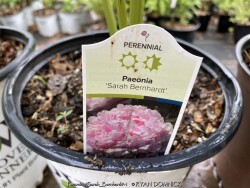

Peonies (Paeonia), along with roses are one of the most universally well-known flowers. The toughness and durability of this plant can be seen in cemeteries or around abandoned houses, surviving decades even 100 years or more without care. Peonies are native to China in cold continental climate areas but also do well in Kansas. Large flowers come in different shades of white, red, and pink. Peonies bloom usually around Memorial Day hence their popularity and cemeteries. Blooming lasts about 2 weeks but can be short-lived if a thunderstorm happens during the last week of blooming when petals are fully open. In zone 6 and south, the foliage is glossy green and attractive throughout the first half of summer. Usually, by late summer, foliage is tattered from drought stress and diseases. This has no ill effect on the health of the plant as it is already set its growth buds for next year. In northern areas (USDA zones 3-5), Peony foliage lasts all summer and turns a brilliant red and orange color in the fall. Due to its need for cold winters, peonies will not grow well further south than zone 8b. Gardeners in south Florida have had success getting peonies to bloom by dumping a bag of ice on the dormant plant every day for 5-6 weeks in winter: sounds like a lot of work huh! Due to its cold tolerance, peonies may be grown in above-ground pots or raised planters year-round. When planting outside, be careful to plant at the correct depth with pink buds slightly below the soil or plants will not bloom. Overall, peonies are a very reliable long-lived plant in Kansas surviving everything. But they do require some maintenance to look their best. Ultra cold-hardy plants from northern climates normally dislike our long hot humid summers; although we are on the Southern edge of this plant's adaptability, it still survives reasonably well here. Look for a cold microclimate planting location such as East or North exposure. Paeonia lactiflora 'Sarah Bernhardt' features enormous, fragrant, double flowers in rose pink with white edges.
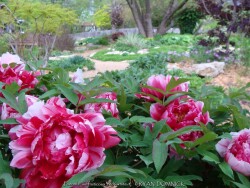

Tree Peonies (Paeonia suffruiticosa) are larger, woody relatives of the common herbaceous (perennial) peony. It does not die to the ground each winter, instead growing up to 3-5 feet after many years. Tree peonies have been in culture in China for millennia. Most "tree" peonies are really just shrubs and are grafted to the rootstock of herbaceous peonies. Peonies, along with roses are one of the most universally well-known flowers. The toughness and durability of this plant can be seen in cemeteries or around abandoned houses, surviving decades even 100 years or more without care. Both tree and herbaceous peonies are native to China in cold continental climate areas but also do well in Kansas. Large flowers come in different shades of white, red, and pink. Blooming only lasts about 3-7 days and can be short-lived if a thunderstorm happens during the second day of blooming when petals are fully open. The foliage is especially attractive in spring when unfurling into a flat, rich green and remains attractive throughout summer. Usually, by early fall, foliage is tattered from drought stress and diseases with no appreciable fall color. This has no ill effect on the health of the plant as it is already set its growth buds for next year. In northern areas (USDA zones 3-6), Peony foliage lasts all summer and turns brilliant red and orange colors in the fall. Due to its need for cold winters, peonies will not grow well further south than zone 8b. Due to its cold tolerance, peonies may be grown in above-ground pots or raised planters year-round. Ultra cold-hardy plants from northern climates normally dislike our long hot humid summers; although we are on the Southern edge of this plant's adaptability, it still survives reasonably well here. Several have been alive for over 15 years and bloom like clockwork each spring here in our Lawrence, KS display garden.
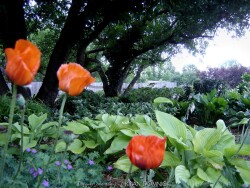

***Description for this perennial available with future update!***>>>>>Ultra cold-hardy plants from northern climates normally dislike our long hot humid summers; although we are on the Southern edge of this plants adaptability, it still survives reasonably well here. Look for a cold microclimate planting location such as East or North exposure.>>>>>
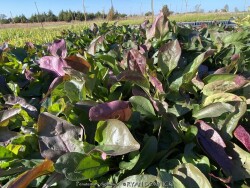

***Description for this perennial available with future update!***Foxglove Beardtongue / Native Penstemon, is also known as Penstemon digitalis. >>>>>
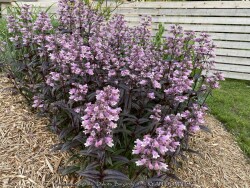

***Description for this perennial available with future update!***Dakota Burgundy Penstemon, is also known as Penstemon digitalis 'Dakota Burgundy'
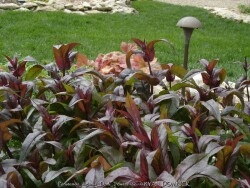

***Description for this perennial available with future update!***Dark Towers Penstemon, is also known as Penstemon digitalis 'Dark Towers'


***Description for this perennial available with future update!***Dakota Burgundy Penstemon, is also known as Penstemon digitalis 'Dakota Burgundy'
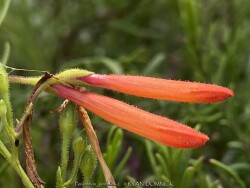

***Description for this perennial available with future update!***
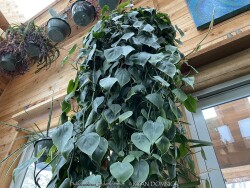

***Description for this plant available with future update!***
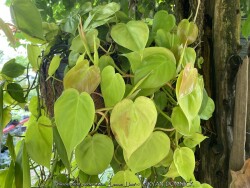

***Description for this plant available with future update!***
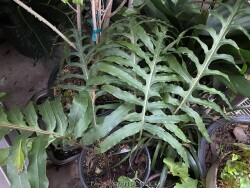

***Description for this plant available with future update!***
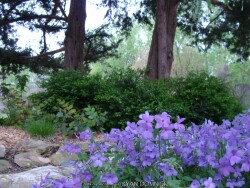

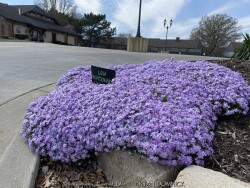

***Description for this perennial available with future update!***Blue Creeping Phlox, is also known as Phlox subulata 'Emerald Blue'
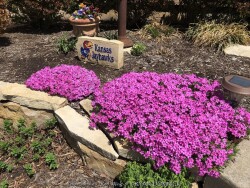

***Description for this perennial available with future update!***Red Creeping Phlox, is also known as Phlox subulata 'Red Wing'
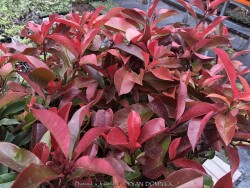

***Shrub descriptions available with future update!***>>>>>Repeated or successive cold winters with complete foliage loss seem to be an issue with this and many evergreen zone 6/7 plants. One occasional difficult winter followed by mild winters is more tolerable. This is, however, a very vigorous growing plant so generally will recover in one summer with decent watering and fertilizer.
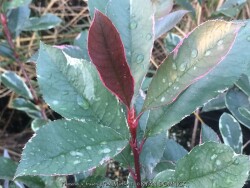

***Shrub descriptions available with future update!***>>>>>Repeated or successive cold winters with complete foliage loss seem to be an issue with this and many evergreen zone 6/7 plants. One occasional difficult winter followed by mild winters is more tolerable. This is, however, a very vigorous growing plant so generally will recover in one summer with decent watering and fertilizer.
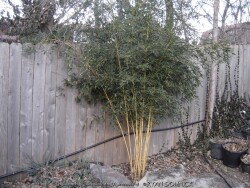

Golden Crookstem Evergreen Bamboo (Phyllostachys aureosulcata 'Aureocaulis') is a cold hardy running bamboo with a distinctive yellow culms. When planted where direct sun can shine on the culms from the south or west, they often develop a bright magenta highlight for a few weeks in the spring. Established bamboo groves provide a beautiful evergreen privacy screen. It provides ultimate wind protection, noise and traffic screening, and a hedge-like barrier. Bamboo is loved for its tropical lush appearance and a proven performance record in cold climates. It offers the only option for dry shade situations that stays green all winter. Bamboo is a great bird and wildlife shelter. You may also create trails through the bamboo grove for kids to play and built forts. Bamboo shoots 1" diameter plus are edible and quite tasty if harvested when under 6" tall and husked like corn. Timber species can obtain a maximum height of 15 to 20 feet may be achieved in 5 to 10 years. Realistic height of 10-15 feet should be expected in Kansas ( zones 5-6 ). Foliage is evergreen to 0 to 5 degrees F. Canes will defoliate at -5 to -10 degrees F. Canes die to the ground at -10 to -15 degrees. Root system will survive up to -25 to -30 degrees F as a perennial especially if mulched. Every few years a grove will experience complete winterkill: it is strongly advised to cut all dead growth to the ground for aesthetic reasons and and fire prevention. In the year after a complete winter-kill event, new growth will only grow back 1/2 as tall as it was before. It is speculated that after loosing all that foliage and biomass, it is only growing with 1/2 as much energy as before and with loss of potential photosynthesis for months in the spring before it is warm enough for new shoots to emerge. In our trial gardens in Lawrence, KS (zone 6a), all plants were killed to the ground but rhizomes survived with new growth by May. During this arctic blast of February, 2021, lows down to -17 degrees F on Feb 16th, 2021 were recorded. The longevity of this cold blast was also impressive: 10 days on a row with highs of 10-15 degrees F or lower, 8 nights of lows in the single digits and negatives, and 36 strait hours of 0 degrees F and mostly lower. As with any running bamboo, it is important to consider future spread. Spread can be controlled in lawn or forested areas by mowing at least twice a month during the months of May, June, and July and once in September. Another method of spread used mainly in China today is the shallow 12" deep sand-filled trench. Every summer, just run a shovel through the trench a few times to sever any escaping rhizomes. Also use this method for easy propagation. To keep bamboo from spreading into other landscape or formal lawn areas, you must install a continuous border around the grove. 14"-16" deep edging is needed for loamy to clay soils; 18-24" deep border is needed for sandy soils. An effective edging material is high-density polyethylene plastic professional rhizome barrier with lots of information available on proper installation techniques.
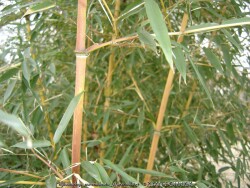

Lama Temple Crookstem Evergreen Bamboo (Phyllostachys aureosulcata 'Lama Temple') is a cold hardy running bamboo with a distinctive sulfur yellow culms. When planted where direct sun can shine on the culms from the south or west, they often develop a bright cherry-red highlight for a few weeks in the spring. Culm sheaths are more pale and pink than other bamboos. Established bamboo groves provide a beautiful evergreen privacy screen. It provides ultimate wind protection, noise and traffic screening, and a hedge-like barrier. Bamboo is loved for its tropical lush appearance and a proven performance record in cold climates. It offers the only option for dry shade situations that stays green all winter. Bamboo is a great bird and wildlife shelter. You may also create trails through the bamboo grove for kids to play and built forts. Bamboo shoots 1" diameter plus are edible and quite tasty if harvested when under 6" tall and husked like corn. Timber species can obtain a maximum height of 15 to 20 feet may be achieved in 5 to 10 years. Realistic height of 10-15 feet should be expected in Kansas ( zones 5-6 ). Foliage is evergreen to 0 to 5 degrees F. Canes will defoliate at -5 to -10 degrees F. Canes die to the ground at -10 to -15 degrees. Root system will survive up to -25 to -30 degrees F as a perennial especially if mulched. Every few years a grove will experience complete winterkill: it is strongly advised to cut all dead growth to the ground for aesthetic reasons and and fire prevention. In the year after a complete winter-kill event, new growth will only grow back 1/2 as tall as it was before. It is speculated that after loosing all that foliage and biomass, it is only growing with 1/2 as much energy as before and with loss of potential photosynthesis for months in the spring before it is warm enough for new shoots to emerge. In our trial gardens in Lawrence, KS (zone 6a), all plants were killed to the ground but rhizomes survived with new growth by May. During this arctic blast of February, 2021, lows down to -17 degrees F on Feb 16th, 2021 were recorded. The longevity of this cold blast was also impressive: 10 days on a row with highs of 10-15 degrees F or lower, 8 nights of lows in the single digits and negatives, and 36 strait hours of 0 degrees F and mostly lower. As with any running bamboo, it is important to consider future spread. Spread can be controlled in lawn or forested areas by mowing at least twice a month during the months of May, June, and July and once in September. Another method of spread used mainly in China today is the shallow 12" deep sand-filled trench. Every summer, just run a shovel through the trench a few times to sever any escaping rhizomes. Also use this method for easy propagation. To keep bamboo from spreading into other landscape or formal lawn areas, you must install a continuous border around the grove. 14"-16" deep edging is needed for loamy to clay soils; 18-24" deep border is needed for sandy soils. An effective edging material is high-density polyethylene plastic professional rhizome barrier with lots of information available on proper installation techniques.
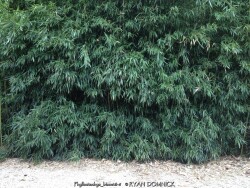

Bissett Dark Green Evergreen Bamboo (Phyllostachys bissetti) is one of the most cold hardy running bamboo there is. Foliage is bright green with dark green culms. Foliage density is very high. Established Bissett bamboo groves provide the most dense beautiful evergreen privacy screen of the cold hardy bamboos. It provides ultimate wind protection, noise and traffic screening, and a hedge-like barrier. Bamboo is loved for its tropical lush appearance and a proven performance record in cold climates. It offers the only option for dry shade situations that stays green all winter. Bamboo is a great bird and wildlife shelter. You may also create trails through the bamboo grove for kids to play and built forts. Bamboo shoots 1" diameter plus are edible and quite tasty if harvested when under 6" tall and husked like corn. Timber species can obtain a maximum height of 15 to 20 feet may be achieved in 5 to 10 years. Realistic height of 10-15 feet should be expected in Kansas ( zones 5-6 ). Foliage is evergreen to -5 to -8 degrees F. Canes will defoliate at -10 to -15 degrees F. Canes die to the ground at -15 to -20 degrees. Root system will survive up to -30 to -35 degrees F as a perennial especially if mulched. Every few years a grove will experience complete winterkill: it is strongly advised to cut all dead growth to the ground for aesthetic reasons and and fire prevention. In the year after a complete winter-kill event, new growth will only grow back 1/2 as tall as it was before. It is speculated that after loosing all that foliage and biomass, it is only growing with 1/2 as much energy as before and with loss of potential photosynthesis for months in the spring before it is warm enough for new shoots to emerge. In our trial gardens in Lawrence, KS (zone 6a), all plants were killed to the ground but rhizomes survived with new growth by May. During this arctic blast of February, 2021, lows down to -17 degrees F on Feb 16th, 2021 were recorded. The longevity of this cold blast was also impressive: 10 days on a row with highs of 10-15 degrees F or lower, 8 nights of lows in the single digits and negatives, and 36 strait hours of 0 degrees F and mostly lower. As with any running bamboo, it is important to consider future spread. Spread can be controlled in lawn or forested areas by mowing at least twice a month during the months of May, June, and July and once in September. Another method of spread used mainly in China today is the shallow 12" deep sand-filled trench. Every summer, just run a shovel through the trench a few times to sever any escaping rhizomes. Also use this method for easy propagation. To keep bamboo from spreading into other landscape or formal lawn areas, you must install a continuous border around the grove. 14"-16" deep edging is needed for loamy to clay soils; 18-24" deep border is needed for sandy soils. An effective edging material is high-density polyethylene plastic professional rhizome barrier with lots of information available on proper installation techniques.
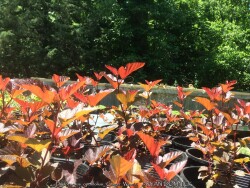

Ginger Wine® Ninebark (Physocarpus opulifolius 'Ginger Wine') expands the color palette for these easy care, native flowering shrubs. Spring foliage emerges a sunny orange color and matures to sparkling burgundy. Clusters of white flowers cover the plant in late spring, and these age to attractive red seed heads. This disease-resistant shrub does best in full sun locations and cooler climates. Top reasons to grow Ginger Wine® ninebark: 1.Colorful from spring through fall. 2. Native to North America. 3. Very low maintenance: no pruning or deadheading required. Ultra cold-hardy plants from northern climates normally dislike our long hot humid summers; although we are on the Southern edge of this plants adaptability, it still survives reasonably well here. It will not handle extreme drought; the Lawrence KS summer of 2011 and 2012 killed many plants that were not under an irrigation system. Look for a cold microclimate planting location such as East or North exposure but still in full sun. All Proven Winners® plants are legally propagated, healthy and vigorous, true to name, and tagged with color pictures and growing information.
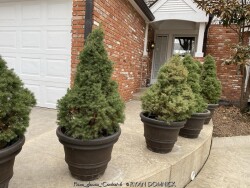

***Shrub descriptions available with future update!***>>>>>Ultra cold-hardy plants from northern climates normally dislike our long hot humid summers; although we are on the Southern edge of this plants adaptability, it still survives reasonably well here. Look for a cold microclimate planting location such as East or North exposure.>>>>>
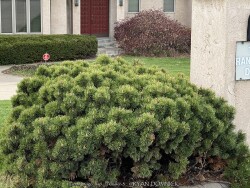

Mugo Pine is a dwarf needled evergreen pine usually ground as a small or large shrub. Native native to high elevation habitats from southern to central Europe, Mugo pine, also called Swiss Mountain Pine, handles plenty of subzero weather hardy down to at least -50. It also has pretty reasonable heat tolerance at least into zone 7. It prefers a rich, well-drained soil but will grow in just about anything including clay as long as it's not waterlogged. Growth rate is extremely variable depending on what cultivar or genetics of the seed grown variety you have. Growth can range from 1 to 15 feet. If needing several plants that will be consistent size, choose a cultivar. In the landscape, it is useful anywhere you need the structure of a needled evergreen shrub. It may also be grown in a raise container year-round as root hardiness will not be a problem in our eastern Kansas zone 6 climate. Maintenance is pretty easy, only needing to watch out for foliage devouring caterpillars and bagworms every so often. After many years, winter pruning is recommended to control size if planted in a tight area. Ultra cold-hardy plants from northern climates normally dislike our long hot humid summers; although we are close to the southern edge of this plants adaptability, it still survives reasonably well here. Look for a cooler microclimate planting location such as East or North exposure. Although not included in our edible plant database, the immature green cones can be picked and eventually dried out to yield drops of sweet tasting syrup and when boiled it is sometimes sold as "pine cone syrup". Obviously, we have not have the time or energy to try this! Much genetic diversity occurs within the species so if needing a specific sized plant, be sure to purchase a named cultivar. Pinus mugo ssp. 'Pumilio' is one of the best mugo pines for dark green color and tight mounding growth upto 3-5' tall and wide.
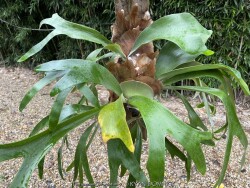

***Description for this plant available with future update!***Staghorn / Elkhorn Fern (Tropical), is also known as Platycerium bifurcatum
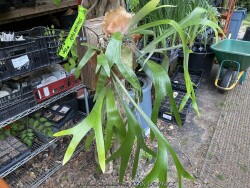

***Description for this plant available with future update!***Staghorn / Elkhorn Fern (Tropical), is also known as Platycerium bifurcatum
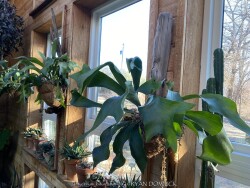

***Description for this plant available with future update!***Staghorn / Elkhorn Fern (Tropical), is also known as Platycerium bifurcatum
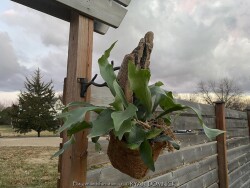

***Description for this plant available with future update!***Staghorn / Elkhorn Fern (Tropical), is also known as Platycerium bifurcatum
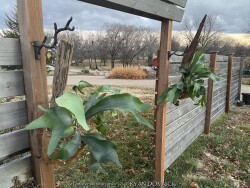

***Description for this plant available with future update!***Staghorn / Elkhorn Fern (Tropical), is also known as Platycerium bifurcatum
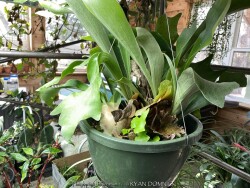

***Description for this plant available with future update!***Staghorn / Elkhorn Fern (Tropical), is also known as Platycerium bifurcatum
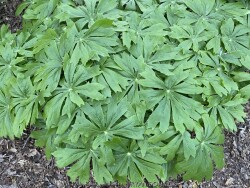

Mayapple (Podophyllum peltatum) is a spring growing perennial with large green umbrella like leaves. White five petal flowers appear on mature plants with green "apple-like" fruits to follow. Mayapple is native to rich woodland areas in Kansas, the Midwest, and most of the eastern United States; it needs rich well-drained soils. Mayapple colonizes by rhizomes forming dense slow-spreading mats making this an easy plant to spot from a distance especially in the early spring. Early spring emergence is normally not a problem as foliage resists normal spring frosts. During the April deep freeze of 2007 in Lawrence, KS, temperatures bottomed out at 18°F after an extra warm March. As a comparison, hosta foliage had completely unfurled was killed to the ground but Mayapple foliage had no damage for several days of the cold blast with temperatures down to 22-24°F! Moderate damage occurred on the last night at 18°F but no long term problems persisted. After summer heat and drought sets in usually by mid June, the foliage disappears completely going dormant until the next spring. Because it goes dormant, summer drought is usually not a problem as long as soil is rich in organic matter and moisture-retentive. Fruit-set is uncommon as vegetative growth is the primary method of propagation. A single-leafed stem will not produce a flower that season. A forked stems bearing two leaves will have a tight flower bud nestled at the base of the two petioles and possible fruit if pollinated. Bees seem to do this work, especially queen bumble bees. Blooms occur at a time of year when other pollen sources are rare thus being very valuable for wild-life. Fruit is sweet and edible, however with caution. Usually one or two fruits is safe but toxic if eaten in larger quantities. Usually, raccoons or possums get to the fruit before humans. This native perennial gives a tropical vibe and is valuable for the early spring foliage, flower, and fruit but be prepared for a bare spot during the rest of summer unless you fill in with summer annuals, late emerging perennials, or mulch to stop weed growth.
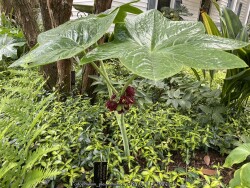

***Description for this perennial available with future update!***Chinese Mayappple >>>>> ***Description for this perennial available with future update!***
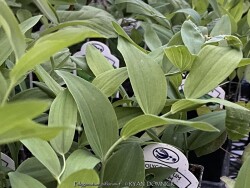

Solomon Seal (Polygonatum sp.) is a very large genus of perennials comprising dozens of species. Many of the species that are appropriate for garden use in Kansas are native to seasonally dry to moist forests in North America and Asia. New growth arises each year from a finger-like slowly spreading rhizome system. The foliage has a central stem with architecturally arranged opposite leaves covering the length of the stem gradually getting smaller towards the end. Small bell-shaped white flowers appear in early spring followed by bluish-purple fruit. Flowers and new spring growth is frost-hardy. Most Solomon seals do well with average garden soils and moisture with many tolerating dry-shade well. Solomon's seal can grow for many years increasing in density without ever needing division. Over time this creates a nearly weed-proof groundcover. in eastern Kansas with 40 inches of rain per year on average, there seems to be plenty of moisture to create extremely healthy patches of Solomon seal that compete well with tree roots. While some species can tolerate sun, there are many better choices as sunburning will likely occur with afternoon sun in temperatures over 95 degrees F. Combine with hostas or other shade plants to create a dramatic effect. Included in our "edibles" database but depends on how hungry you are! Polygonatum biflorum, also known as Smooth solomon's-seal, is native to Kansas and Central U.S. forests in average to moist conditions including dry-shade. It adds a bright splash of light green to the shade garden. Fruiting does occur and desirable self-seeding occurs within the patch. Plants reach heights of 18-24" tall in Kansas. Fall color is a brilliant yellow for a week before going dormant. Maintenance is easy as stems easily detach when raking with fall clean-up. If cosmetic foliage leaf-rust is a problem, just cut back early. During the April deep freeze of 2007, temperatures bottomed out at 18°F after an extra warm March. Hosta and Solomon seal foliage had completely unfurled and was flowering. All hostas were killed to the ground but solomon seal foliage and flowers survived un-damaged! A great "Once it's there, it's there forever" plant for dry-shade!
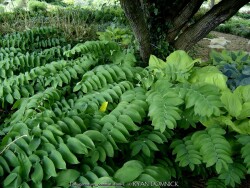

Solomon Seal (Polygonatum sp.) is a very large genus of perennials comprising dozens of species. Many of the species that are appropriate for garden use in Kansas are native to seasonally dry to moist forests in North America and Asia. New growth arises each year from a finger-like slowly spreading rhizome system. The foliage has a central stem with architecturally arranged opposite leaves covering the length of the stem gradually getting smaller towards the end. Small bell-shaped white flowers appear in early spring followed by bluish-purple fruit. Flowers and new spring growth is frost-hardy. Most Solomon seals do well with average garden soils and moisture with many tolerating dry-shade well. Solomon's seal can grow for many years increasing in density without ever needing division. Over time this creates a nearly weed-proof groundcover. in eastern Kansas with 40 inches of rain per year on average, there seems to be plenty of moisture to create extremely healthy patches of Solomon seal that compete well with tree roots. While some species can tolerate sun, there are many better choices as sunburning will likely occur with afternoon sun in temperatures over 95 degrees F. Combine with hostas or other shade plants to create a dramatic effect. Included in our "edibles" database but depends on how hungry you are! Polygonatum commutatum, also known as Great Solomon's seal, is native to Eastern U.S. forests in average to moist conditions. It adds a bright splash of light green to the shade garden. Fruiting does occur and desirable self-seeding occurs within the patch. Plants reach heights of 24-36" tall in Kansas. Fall color is a brilliant yellow for a week before going dormant. Maintenance is easy as stems easily detach when raking with fall clean-up. If cosmetic foliage leaf-rust is a problem, just cut back early. During the April deep freeze of 2007, temperatures bottomed out at 18°F after an extra warm March. Hosta and Solomon seal foliage had completely unfurled and was flowering. All hostas were killed to the ground but solomon seal foliage and flowers survived un-damaged! A great "Once it's there, it's there forever" plant for dry-shade!
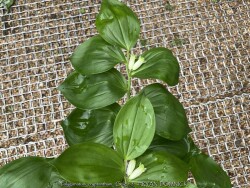

Solomon Seal (Polygonatum sp.) is a very large genus of perennials comprising dozens of species. Many of the species that are appropriate for garden use in Kansas are native to seasonally dry to moist forests in North America and Asia. New growth arises each year from a finger-like slowly spreading rhizome system. The foliage has a central stem with architecturally arranged opposite leaves covering the length of the stem gradually getting smaller towards the end. Small bell-shaped white flowers appear in early spring followed by bluish-purple fruit. Flowers and new spring growth is frost-hardy. Most Solomon seals do well with average garden soils and moisture with many tolerating dry-shade well. Solomon's seal can grow for many years increasing in density without ever needing division. Over time this creates a nearly weed-proof groundcover. in eastern Kansas with 40 inches of rain per year on average, there seems to be plenty of moisture to create extremely healthy patches of Solomon seal that compete well with tree roots. While some species can tolerate sun, there are many better choices as sunburning will likely occur with afternoon sun in temperatures over 95 degrees F. Combine with hostas or other shade plants to create a dramatic effect. Included in our "edibles" database but depends on how hungry you are! Hidden Flower Solomon's Seal (Polygonatum cryptanthum 'Crug') is one of the most attractive solomon seals in our display garden. This species forms a tight clump of slow-spreading rhizomes with bubbly, shiny green foliage 12" tall. Stems feature rows of small, white, clustered bells that do not open fully and are attached just below the leaf intersections. Brilliant blue fruit ripens late summer and fall. Fall color is a brilliant yellow for a week before going dormant. Maintenance is easy as stems easily detach when raking with fall clean-up. If cosmetic foliage leaf-rust is a problem, just cut back early. A great "Once it's there, it's there forever" plant for dry-shade! Rarely available for sale as propagation is slow.
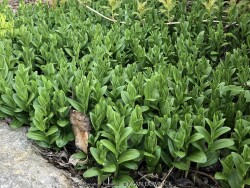

Solomon Seal (Polygonatum sp.) is a very large genus of perennials comprising dozens of species. Many of the species that are appropriate for garden use in Kansas are native to seasonally dry to moist forests in North America and Asia. New growth arises each year from a finger-like slowly spreading rhizome system. The foliage has a central stem with architecturally arranged opposite leaves covering the length of the stem gradually getting smaller towards the end. Small bell-shaped white flowers appear in early spring followed by bluish-purple fruit. Flowers and new spring growth is frost-hardy. Most Solomon seals do well with average garden soils and moisture with many tolerating dry-shade well. Solomon's seal can grow for many years increasing in density without ever needing division. Over time this creates a nearly weed-proof groundcover. in eastern Kansas with 40 inches of rain per year on average, there seems to be plenty of moisture to create extremely healthy patches of Solomon seal that compete well with tree roots. While some species can tolerate sun, there are many better choices as sunburning will likely occur with afternoon sun in temperatures over 95 degrees F. Combine with hostas or other shade plants to create a dramatic effect. Tiny Green Solomon's Seal (Polygonatum humile) is a miniture groundcover solonons seal only 4-8" tall. This cute plant is everything "solomon seal" just miniture! Best growth occurs in average to wet soils in part shade to full shade. Slowly spreading thin rhizomes form a colony in optimum growing conditions. In dry shade, the plant survives but goes dormant by mid-summer paving the way for weeds to come in so avoid these conditions.
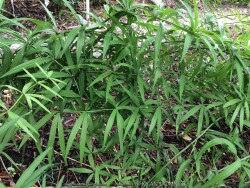

Solomon Seal (Polygonatum sp.) is a very large genus of perennials comprising dozens of species. Many of the species that are appropriate for garden use in Kansas are native to seasonally dry to moist forests in North America and Asia. Orange Flowering Climbing Solomon's Seal (Polygonatum kingianum / huanum) is definitely not typical of the genus! This plant has "climbed" above other Solomon seals! New vining growth several feet tall arises each year from a non-spreading rhizome. The foliage has a central stem with architecturally arranged opposite leaves covering the length of the stem gradually getting smaller towards the end. Two tiny hooks are located on the tips of each leaf, helping it to gently cling onto a structure or other plant for support. Elongated bell-shaped flowers appearing in spring are orange with green tips, yes ORANGE! This small "vine-like" plant is a curiosity and specimen plant. Grow in moist, well drained forest soil with average irrigation. This beauty can reach 12' tall but in our Kansas display garden, we are on year 3 (2021) with growth about 3' and increasing each year.
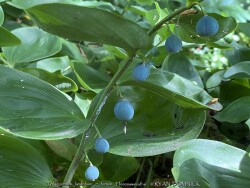

Solomon Seal (Polygonatum sp.) is a very large genus of perennials comprising dozens of species. Many of the species that are appropriate for garden use in Kansas are native to seasonally dry to moist forests in North America and Asia. New growth arises each year from a finger-like slowly spreading rhizome system. The foliage has a central stem with architecturally arranged opposite leaves covering the length of the stem gradually getting smaller towards the end. Small bell-shaped white flowers appear in early spring followed by bluish-purple fruit. Flowers and new spring growth is frost-hardy. Most Solomon seals do well with average garden soils and moisture with many tolerating dry-shade well. Solomon's seal can grow for many years increasing in density without ever needing division. Over time this creates a nearly weed-proof groundcover. in eastern Kansas with 40 inches of rain per year on average, there seems to be plenty of moisture to create extremely healthy patches of Solomon seal that compete well with tree roots. While some species can tolerate sun, there are many better choices as sunburning will likely occur with afternoon sun in temperatures over 95 degrees F. Combine with hostas or other shade plants to create a dramatic effect. Included in our "edibles" database but depends on how hungry you are! Wide-leaf Solomon's Seal (Polygonatum latifolium / hirtum 'Heronswood') is one of the most attractive solomon seals in our display garden. This species forms a tight clump of slow-spreading rhizomes with bubbly, shiny green foliage on stems 12" tall. Stems feature rows of small, white, clustered bells, attached just below the leaf intersections. Brilliant blue fruit ripens late summer and fall. Fall color is a brilliant yellow for a week before going dormant. Maintenance is easy as stems easily detach when raking with fall clean-up. If cosmetic foliage leaf-rust is a problem, just cut back early. A great "Once it's there, it's there forever" plant for dry-shade! Rarely available for sale as propagation is slow.
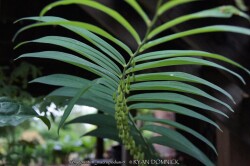

Solomon Seal (Polygonatum sp.) is a very large genus of perennials comprising dozens of species. Many of the species that are appropriate for garden use in Kansas are native to seasonally dry to moist forests in North America and Asia. New growth arises each year from a finger-like slowly spreading rhizome system. The foliage has a central stem with architecturally arranged opposite leaves covering the length of the stem gradually getting smaller towards the end. Small bell-shaped white flowers appear in early spring followed by bluish-purple fruit. Flowers and new spring growth is frost-hardy. Most Solomon seals do well with average garden soils and moisture with many tolerating dry-shade well. Solomon's seal can grow for many years increasing in density without ever needing division. Over time this creates a nearly weed-proof groundcover. in eastern Kansas with 40 inches of rain per year on average, there seems to be plenty of moisture to create extremely healthy patches of Solomon seal that compete well with tree roots. While some species can tolerate sun, there are many better choices as sunburning will likely occur with afternoon sun in temperatures over 95 degrees F. Combine with hostas or other shade plants to create a dramatic effect. Included in our "edibles" database but depends on how hungry you are! Big Footed Solomon's Seal (Polygonatum macropodum) is the largest and most architectural solomon seal in our display garden. This species forms a tight clump of slow-spreading rhizomes with symmetrical foliage upto 4' long. Stems feature long rows of small, white, clustered bells, attached just below the leaf intersections. Blue fruit ripens late summer and fall. Fall color is a brilliant yellow for a week before going dormant. Maintenance is easy as stems easily detach when raking with fall clean-up. If cosmetic foliage leaf-rust is a problem, just cut back early. During the April deep freeze of 2007, temperatures bottomed out at 18°F after an extra warm March. Hosta and Solomon seal foliage had completely unfurled and was flowering. All hostas were killed to the ground but solomon seal foliage and flowers survived un-damaged! A great "Once it's there, it's there forever" plant for dry-shade! Rarely available for sale as propagation is slow.
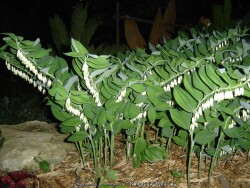

Solomon Seal (Polygonatum sp.) is a very large genus of perennials comprising dozens of species. Many of the species that are appropriate for garden use in Kansas are native to seasonally dry to moist forests in North America and Asia. New growth arises each year from a finger-like slowly spreading rhizome system. The foliage has a central stem with architecturally arranged opposite leaves covering the length of the stem gradually getting smaller towards the end. Small bell-shaped white flowers appear in early spring followed by bluish-purple fruit. Flowers and new spring growth is frost-hardy. Most Solomon seals do well with average garden soils and moisture with many tolerating dry-shade well. Solomon's seal can grow for many years increasing in density without ever needing division. Over time this creates a nearly weed-proof groundcover. in eastern Kansas with 40 inches of rain per year on average, there seems to be plenty of moisture to create extremely healthy patches of Solomon seal that compete well with tree roots. While some species can tolerate sun, there are many better choices as sunburning will likely occur with afternoon sun in temperatures over 95 degrees F. Combine with hostas or other shade plants to create a dramatic effect. Included in our "edibles" database but depends on how hungry you are! Medium Green Japanese Solomon's Seal (Polygonatum odoratum) adds a bright splash of light green to the shade garden. Fruiting does not occur on this variety like others. Height is uniformly 18-24" tall. Fall color is a brilliant yellow for a week before going dormant. Maintenance is easy as stems easily detach when raking with fall clean-up. If cosmetic foliage leaf-rust is a problem, just cut back early. During the April deep freeze of 2007, temperatures bottomed out at 18°F after an extra warm March. Hosta and Solomon seal foliage had completely unfurled and was flowering. All hostas were killed to the ground but solomon seal foliage and flowers survived un-damaged! A great "Once it's there, it's there forever" plant for dry-shade!